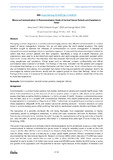| dc.contributor.author | Caren, C. | |
| dc.contributor.author | Kurgat, K. | |
| dc.contributor.author | Mose, George N. | |
| dc.date.accessioned | 2021-04-19T09:49:20Z | |
| dc.date.available | 2021-04-19T09:49:20Z | |
| dc.date.issued | 2019-02 | |
| dc.identifier.citation | JOURNAL OF SOCIAL SCIENCE RESEARCH, 14, 3114–3121. https://doi.org/10.24297/jssr.v14i0.8134 | en_US |
| dc.identifier.uri | https://www.researchgate.net/publication/331436210_SILENCE_AS_COMMUNICATION_A_PHENOMENOLOGICAL_STUDY_OF_CERVICAL_CANCER_PATIENTS_AND_CAREGIVERS_IN_KENYA | |
| dc.identifier.uri | http://library.kisiiuniversity.ac.ke:8080/xmlui/handle/123456789/935 | |
| dc.identifier.uri | https://rajpub.com/index.php/jssr/article/view/8134 | |
| dc.identifier.uri | https://www.semanticscholar.org/paper/SILENCE-AS-COMMUNICATION%3A-A-PHENOMENOLOGICAL-STUDY-Jerop-Kurgat/2c294940381189660cde8e6f5dd4d8e010517cd5 | |
| dc.identifier.uri | https://www.academia.edu/40294838/Silence_as_Communication_A_Phenomenological_Study_of_Cervical_Cancer_Patients_and_Caregivers_in_Kenya | |
| dc.identifier.uri | http://hdl.handle.net/123456789/4586 | |
| dc.description.abstract | Managing a serious diagnosis is a complex and challenging process thus effective communication is a critical aspect of cancer management. However, this has not been given the much needed emphasis. This study therefore sought to examine the influence of communication on cancer management. It adopted an interpretivist research paradigm which is a qualitative approach. It employed the phenomenological method to obtain data from cervical patients and their caregivers. Specifically, a range of in-depth interviews and observations were used to collect data from eight patients and eight caregivers purposively sampled within Uasin Gishu County. Data from the interviews were then analyzed thematically and presented in narrative form using paraphrases and quotations. Ethical issues such as informed consent, confidentiality and official authorization were observed at all levels. The findings of the study indicated that the patients and caregiver downplayed their feelings so as to protect themselves and their loved ones. Social cultural factors and stigma also contributed to their silence. It is concluded that silence is draining and patients and caregivers need to be encouraged by medical practitioners, family and the support groups to share their feelings. Based on the findings of this study, it is necessary for the patients and caregivers to have a platform where they will be able to share their experience. | en_US |
| dc.language.iso | en | en_US |
| dc.subject | Communication, cervical cancer patients, caregiver, silence. | en_US |
| dc.title | Silence as Communication: A Phenomenological Study of Cervical Cancer Patients and Caregivers in Kenya | en_US |
| dc.type | Article | en_US |

